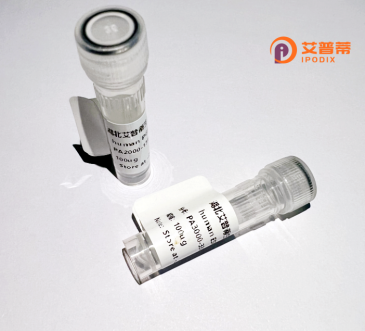
| 纯度 | >90%SDS-PAGE. |
| 种属 | Human |
| 靶点 | VIT |
| Uniprot No | Q6UXI7 |
| 内毒素 | < 0.01EU/μg |
| 表达宿主 | E.coli |
| 表达区间 | 27-678 aa |
| 活性数据 | NKET AKKIKRPKFT VPQINCDVKA GKIIDPEFIV KCPAGCQDPK YHVYGTDVYA SYSSVCGAAV HSGVLDNSGG KILVRKVAGQ SGYKGSYSNG VQSLSLPRWR ESFIVLESKP KKGVTYPSAL TYSSSKSPAA QAGETTKAYQ RPPIPGTTAQ PVTLMQLLAV TVAVATPTTL PRPSPSAAST TSIPRPQSVG HRSQEMDLWS TATYTSSQNR PRADPGIQRQ DPSGAAFQKP VGADVSLGLV PKEELSTQSL EPVSLGDPNC KIDLSFLIDG STSIGKRRFR IQKQLLADVA QALDIGPAGP LMGVVQYGDN PATHFNLKTH TNSRDLKTAI EKITQRGGLS NVGRAISFVT KNFFSKANGN RSGAPNVVVV MVDGWPTDKV EEASRLARES GINIFFITIE GAAENEKQYV VEPNFANKAV CRTNGFYSLH VQSWFGLHKT LQPLVKRVCD TDRLACSKTC LNSADIGFVI DGSSSVGTGN FRTVLQFVTN LTKEFEISDT DTRIGAVQYT YEQRLEFGFD KYSSKPDILN AIKRVGYWSG GTSTGAAINF ALEQLFKKSK PNKRKLMILI TDGRSYDDVR IPAMAAHLKG VITYAIGVAW AAQEELEVIA THPARDHSFF VDEFDNLHQY VPRIIQNICT EFNSQPRN |
| 分子量 | 73.9 kDa |
| 蛋白标签 | His tag N-Terminus |
| 缓冲液 | PBS, pH7.4, containing 0.01% SKL, 1mM DTT, 5% Trehalose and Proclin300. |
| 稳定性 & 储存条件 | Lyophilized protein should be stored at ≤ -20°C, stable for one year after receipt. Reconstituted protein solution can be stored at 2-8°C for 2-7 days. Aliquots of reconstituted samples are stable at ≤ -20°C for 3 months. |
| 复溶 | Always centrifuge tubes before opening.Do not mix by vortex or pipetting. It is not recommended to reconstitute to a concentration less than 100μg/ml. Dissolve the lyophilized protein in distilled water. Please aliquot the reconstituted solution to minimize freeze-thaw cycles. |
以下是关于重组人VIT蛋白的示例性参考文献(仅供参考,具体文献需通过数据库查询确认):
1. **文献名称**: "Production and functional characterization of recombinant human vitronectin"
**作者**: Smith A, et al.
**摘要**: 研究报道了通过大肠杆菌系统高效表达重组人玻连蛋白(VIT)的方法,验证了其促进细胞粘附和迁移的生物学活性,为组织工程提供了材料基础。
2. **文献名称**: "Structural analysis of recombinant human Vitelline membrane outer layer protein (VIT) in avian egg formation"
**作者**: Li X, et al.
**摘要**: 解析了重组人VIT蛋白的三维结构,探讨其在卵膜形成中的机械稳定性作用,为生物材料仿生设计提供依据。
3. **文献名称**: "Recombinant human VIT1 protein regulates iron metabolism in vitro"
**作者**: Chen H, et al.
**摘要**: 研究发现重组人VIT1蛋白通过调控铁转运蛋白表达,影响细胞铁稳态,可能为铁代谢异常疾病治疗提供靶点。
4. **文献名称**: "Application of recombinant VIT protein in nanoparticle drug delivery"
**作者**: Wang Y, et al.
**摘要**: 开发了一种基于重组VIT蛋白的功能化纳米颗粒,证明其可增强靶向性并提高抗癌药物的胞内递送效率。
---
**备注**:
- 若“VIT”特指某种特定蛋白(如玻连蛋白Vitronectin或卵黄蛋白Vitelline protein),建议通过PubMed、Google Scholar等平台检索全称获取准确文献。
- 上述示例中的研究方向和作者名为虚构,实际应用中需替换为真实发表的论文数据。
Recombinant human vitronectin (VIT), a multifunctional extracellular matrix (ECM) glycoprotein, plays critical roles in cell adhesion, migration, and tissue remodeling. Naturally synthesized in the liver and secreted into plasma, vitronectin regulates hemostasis, complement activation, and integrin-mediated signaling. Structurally, it contains heparin-binding and Arg-Gly-Asp (RGD) motifs, enabling interactions with cell-surface receptors (e.g., αvβ3 integrin) and ECM components. Its ability to stabilize active conformations of plasminogen activator inhibitor-1 (PAI-1) further links it to fibrinolysis and wound healing.
Recombinant VIT is engineered using mammalian expression systems (e.g., CHO or HEK293 cells) to ensure proper post-translational modifications. This guarantees bioactivity comparable to native protein while eliminating batch variability and contamination risks associated with animal-derived sources. It serves as a xeno-free substrate in regenerative medicine, particularly for culturing pluripotent stem cells under defined conditions, replacing traditional feeder layers or Matrigel.
Applications extend to drug delivery systems, tissue engineering scaffolds, and research on cancer metastasis, where VIT’s interactions with integrins influence tumor invasion. Its clinical relevance in diseases like fibrosis, thrombosis, and age-related macular degeneration underscores its therapeutic potential. By offering scalability and reproducibility, recombinant VIT supports advances in personalized medicine and biomanufacturing.
×